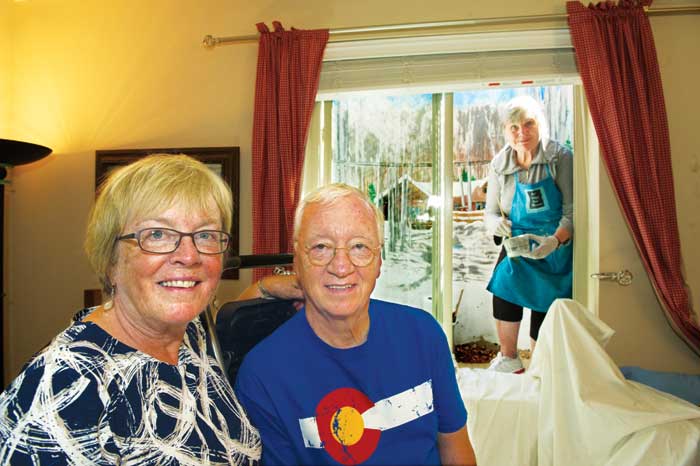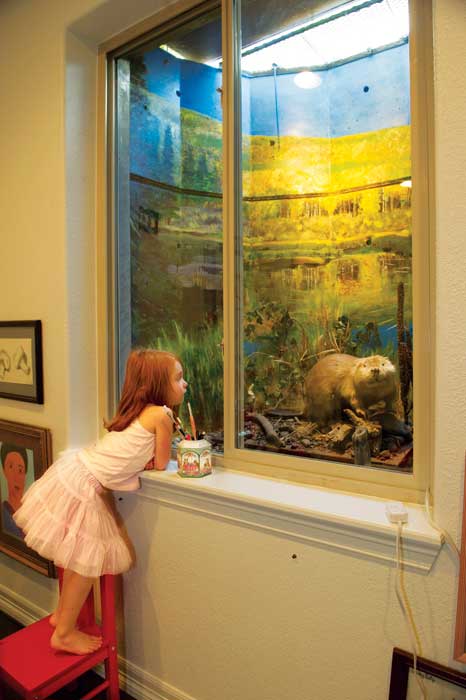
Joan and Bill Betz sit in the basement guest room where artist Carol Sass Tuttle is painting a scene of their family’s cabin on the window well. Front Porch photos by Laura Mahony.
Basements, by their subterranean nature, don’t have views, unless you count the window wells of grey cement or corrugated metal. But head down the stairs of some Stapleton residents’ homes and discover views of family cabins, mountain vistas, city skylines, garden paths or even the 7th hole at Pebble Beach.
Tom McDougle and his wife, artist Valli Thayer McDougle, wished for a mountain view from their ranch-style home, but didn’t have one. About five years ago, Tom got the idea to have someone paint attractive scenes on their basement window wells like he had seen elsewhere, in plastic versions. The couple consulted with their friend Carol Sass Tuttle, an artist with theater set design experience, to see if she would do the job. Valli wasn’t interested in doing the work herself since she usually does abstract painting using watercolors, acrylic and mixed media.

Thalia Hoke peers into the window well mural at her grandparents’ Stapleton home.
When The McDougles met Bill and Joan Betz in the park one day, they invited their new friends and fellow Stapleton residents to their house to see their window well works of art. The Betzes loved them and hired Tuttle to do their window wells too.
Tuttle asked the Betzes what they wished they could see out their windows. The family’s mountain cabin of 41 years in the Gore Range came to mind. When the project is complete, four window wells will display views of the cabin in four seasons. Props became an additional element for perspective as much as for whimsy. Bill found a stuffed beaver online and beaver-chewed logs near the cabin, adding them to a painting that shows a beaver dam. The couple’s grandchildren are also represented, as is the family dog. “Every time we go down to our basement, it’s evocative of our memories of the cabin our kids grew up with,” says Bill.

A mural in the Betz’s basement family room shows a mountain scene near their cabin with their grandchildren walking together and a friendly troll from the kids’ favorite book.
Both couples rigged small lights with dimmer switches inside their window wells to illuminate the murals any time of day, which they feel adds to their enjoyment of them. A piece of polycarbonate on top of the window grates helps keep debris and moisture out.
“It’s a real pleasure to walk down and see the murals,” says Joan. “It adds so much more to those rooms than I would have imagined.” To Tuttle, it’s like set design. “You turn the lights on, the play takes place and it just becomes the background. When you enter and use the room, you just have something pretty to look at instead of that cement wall. It’s an illusion. It’s all about the magic of art.”
The McDougles chose three distinctly different images rather than all one theme, as in the Betzes’ home. Tuttle created a mountain scene for their family room, a flowering path for the bedroom and the 7th hole of Pebble Beach for Tom’s office. While painting the mountain scene, Tuttle suggested including cut logs from her yard to represent trees in the foreground of the mural. With the addition of grasses bought from a hobby store, a multidimensional diorama emerged. For the flowering path, Tom even built a small gate and Valli added artificial flowers to create the illusion of taking a stroll into the mural. “Even though I know it’s on concrete, you see the perspective,” says Valli.
Painting on a canvas of window wells isn’t entirely outside the realm of what Tuttle was used to. Initially a commercial artist, she moved into watercolors and then to set design for her children’s school plays. Painting large sets translated well to painting murals on window wells. Her interest in it was fueled by her love of the dioramas she saw years ago at the Denver Museum of Nature & Science. “This is kind of my mini version of satisfying that. It’s a dream come true to get to do them,” says Tuttle.
While they are not a traditional artist’s canvas, Tuttle looks at the cement or corrugated metal surfaces as a unique challenge. The corrugated window wells pose the greatest obstacle because of the rippled surface but Tuttle says more abstract or linear images work best such as cityscapes. Holes, bolts, globs of cement and even escape ladders don’t phase Tuttle either. She incorporates them into the mural, even painting the ladder so it blends in. “You can’t even see it when it’s done,” she says. “A lot of artists can’t take the limitations. I can. I think I excel on limitations. Throw some more at me!”
Tuttle works 6–7 hours at a stretch. The average mural takes 14 hours but varies depending on the size of the window well and the level of detail the homeowner wants.




0 Comments